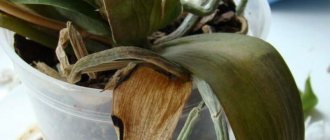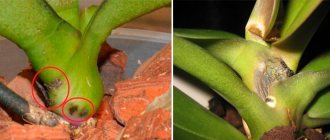Overwatering is perhaps the most common cause of orchid death . In combination with the carelessness of the grower, errors in watering lead to the loss of orchid roots.
How to fix this - read this article. Repeated mistakes in an attempt to correct old ones can provoke the death of the entire plant.
Why does an orchid die?
The main reasons for the death of the culture are the inconsistency of the conditions of detention with the requirements. Significant temperature changes, waterlogging of the substrate, and critical lack of lighting can be detrimental to it.
Most often, problems arise during the cold season. The flower reacts negatively to the following factors:
- dry air during heating operation;
- cold coming from the glass when kept on the window;
- watering with hard water;
- overheating or burns when exposed to sunlight;
- constantly wet substrate combined with low temperature;
- excess or improper application of fertilizers;
- violation of root aeration due to too compacted substrate;
- infection by insect pests or fungal diseases.
If the necessary conditions are not created and the factors affecting the well-being of the flower are not eliminated, it will soon begin to die.
How do you understand that Phalaenopsis has begun to perish and die?
You can determine that an orchid is experiencing problems by its appearance. It is worth paying attention to the presence of the following signs:
- sluggish, gradually yellowing leaves;
- yellowing of shoots, starting from the crown;
- absence of buds (more than 3 months);
- changing the position of the plant in the pot;
- drying and hanging of aerial roots;
- green plaque and algae inside the pot.
If at least one of these signs is present, it is worth removing the flower from the flowerpot and inspecting the root system. Signs of problems with roots:
- brown or black color;
- soft to the touch;
- release of liquid when pressed;
- filamentous structure.
The role of hydration
Moisturizing is the most important thing in plant care. Both a lack and an excess of water are detrimental to it.
The most important condition for watering is maintaining fluid balance. In flower shops you can only find hybrids of tropical orchids. Specimens from the wild forest are extremely rare.
Plants from stores prefer woody substrate and high humidity. Many orchid growers make the following mistakes when watering :
- Use hard tap water.
- Collect melt or rain water.
- Acidify the water with oxalic acid.
What to do if the plant is flooded?
Excessive moistening of the substrate is the main mistake of novice gardeners. The roots of an orchid are special, and you cannot water it like other crops. You can tell that a plant is flooded by the color of the roots in the pot. Then the leaves begin to wrinkle and the buds fall off. If measures are not taken, the flower will soon begin to die.
Important! Most often, overflow occurs if, when immersing a pot in a container of water, they forget to remove it in time. A substrate overflowing with moisture is detrimental to an orchid.
Eliminating flooding and overflow
The only way to cope with flooding or overflowing is to transplant the flower into a fresh substrate and replace the pot. Operating procedure:
- The plant is carefully removed from the pot. It cannot be pulled out, otherwise the roots will break. It is better to carefully cut the pot into two parts and remove them.
- The substrate is cleaned from the roots, washed with warm water and inspected.
- Use sharp, disinfected scissors to cut off the rotten parts.
- After drying, the sections are powdered with crushed charcoal or cinnamon.
- Spray the roots with fungicide and leave the rosette to dry for a day.
- Drainage is placed at the bottom of the new pot, freshly prepared substrate is poured in a thin layer and the orchid is placed on it. The free space between the roots is covered with substrate, leaving the root collar on the surface.
Carefully! Inexperienced gardeners try to dry a waterlogged substrate by heating it with a hair dryer. The hot air flow acts on the flower like a real hurricane. From such help he will not recover, but will definitely die!
How not to overwater an orchid?
The plant requires strictly controlled moistening of the substrate in different phases of development, at different temperature and humidity levels in the room. For an orchid, both overdrying and overmoistening are equally dangerous.
On average, the frequency of watering is as follows:
- during the active growing season - 2 times a week;
- during flowering and in very hot periods - every other day;
- during the rest period - once every 2-3 weeks.
When regulating moisture, it is also worth considering the type of orchid:
- Cymbidium, Phalaenopsis, Paphiopedilum are watered when perspiration disappears on the inside of the walls of the pot.
- Cattleya, Oncidium, Odontoglossum, Dendrobium require the substrate to dry completely before the next watering.
- Vanda needs daily spraying from a spray bottle.
Important! For irrigation, use exclusively soft, settled or filtered water at a temperature of 30-35 degrees.
Basic rules of watering
If a woman overwaters a flower, it means she did something wrong. The need for hydration for each individual orchid occurs individually and depends on many reasons :
- The habit of the plant itself;
- External conditions;
- Care;
- Microclimate;
- Planting method;
- Pot sizes;
- Substrate moisture capacity, etc.
You need to accept that you need to water orchids only when they need it , and not according to a schedule.
Advice! All these factors must be taken into account and learn to understand your plants and their needs at a certain point in time.
How to revive a flower at home?
The method of resuscitation of a dying flower depends on its condition and the problem that has arisen.
How to revive rotten roots?
Exotica with completely rotten roots are restored after their complete removal. The gardener’s task is to grow a new root system on the surviving rosette.
According to gardeners, the most effective way is to hang the rosette above the water:
- After removing the rotten roots, the sections are dried for several hours and treated with charcoal.
- Water is poured into a transparent vessel and the rosette is hung with a wire so that the lower part is located 1-2 cm short of the liquid.
- The container is installed in a warm (23-25 degrees) room in a place with diffused but intense lighting.
- During the process of growing roots, monitor the liquid level and add it as necessary. To prevent the leaves from drying out, they are wiped with a solution of succinic acid or the drug “Doctor Foley”. This will help the orchid gain strength and energy.
New roots are formed within 2-2.5 months. As soon as their length reaches 5-6 cm, the plant is planted in a pot with sphagnum moss. This material has good moisture capacity and at the same time increased breathability, which will help the weakened plant recover faster. After complete resuscitation and root growth, the orchid is transplanted into a substrate familiar to this type of plant.
How to save an orchid when it is overheated?
Keeping the crop in a too hot, dry room or in direct sunlight can also cause its death. Signs of overheating:
- wilting leaves (often with light spots or yellow tips);
- yellowish tint and wrinkling of roots;
- dryness and fragility of aerial roots.
If the plant overheats, remove it from the windowsill to a cool place to cool.
Important! A flower damaged by high temperature can be watered only after it has cooled, after 3-4 hours. Immediate moistening of the substrate will cause instant death of the roots!
How does a flower grow when there is not enough light?
Signs of a lack of lighting are wrinkled or small leaves of a dull shade. The flower looks drooping, unhealthy, and does not bloom for a long time. The roots gradually begin to rot as photosynthesis processes in them are disrupted.
It will be possible to revive the plant only if it is provided with bright, diffused lighting for at least 12 hours a day. The best place for growing is an east or west window. In winter or in cloudy weather, the orchid is illuminated with fluorescent or phytolamps.
If the plant is sick
Overmoistening or overheating of a crop is dangerous not only in itself. They provoke the development of diseases on the plant. Signs of diseases depend on their type:
- Fungal - appear as a white or gray coating, spots, stains on the leaves.
- Bacterial - cause rotting of roots, blackening of leaves and pseudobulbs, followed by their death. Often the leaves become covered with weeping spots, and an unpleasant odor emanates from the plant.
The drug Fitosporin has proven itself well in the treatment of fungal diseases. They are treated 2-3 times with an interval of 7 days.
Bacterial diseases can only be treated at an early stage. First, all affected parts of the plant are removed, healthy parts are wiped with antibiotic slurry. Experts advise using the drug Chlorhexidine. To restore after treatment, reduce watering and lower the temperature to 22-23 degrees.
Quick help for an orchid
In saving an exotic animal (when diagnosing problems), it is important to provide him with first aid correctly. Any violation of the appearance of the plant requires immediate action:
- swelling, plaque and yellowing of leaves is caused by a fungus. The affected parts are removed, the cut areas are treated with a fungicide;
- when bacterial spots appear on old leaves, they are pruned and treated with activated carbon;
- the plant with dried leaves and roots is transplanted into a new substrate;
- if voluminous waxy growths or holes are noticed on the leaves, treat them with insecticides against pests.
How to prevent Phalaenopsis from dying?
Careful adherence to recommendations for living conditions and care rules helps prevent problems when growing orchids:
- Compliance with watering standards. Phalaenopsis is a special flower that needs to be “watered” periodically. The next portion of moisture is added to the substrate only after the roots have absorbed the previous one. The root system must breathe, so it cannot constantly be in water.
- Providing intense lighting for at least 12-14 hours a day. Without a large amount of scattered sunlight, the plant loses its immunity. The roots weaken and cannot provide it with nutrients.
- Proper feeding. The main enemy of the orchid, which leads to rotting of the roots, is an excess of nitrogen. Fertilizing is carried out taking into account the phase of vegetative development of the plant. In this case, the dosage is reduced by 2-3 times to avoid overfeeding.
- Maintaining a humidity level of at least 60%. If there is not enough moisture in the air, the pot with the plant is placed on a tray with expanded clay. It must first be filled with water, an automatic humidifier must be installed in the room, and additional spraying of the leaves and roots should be carried out.
You shouldn’t throw away a limp, dried out or even rootless orchid. With some effort and patience, she can be saved. A life-loving flower will “take advantage of the chance for salvation,” the main thing is to choose the right method. Before using any method of resuscitation, you should first familiarize yourself with the recommendations of specialists and experienced flower growers. Wrong actions in this situation can aggravate the deplorable condition of the plant.
5/5 — (1 vote)
Prevention and further care
To prevent repeated flooding, it is necessary to further carefully control the plant’s moisture . By following the above watering rules, such mistakes will not be repeated. An orchid that is recovering from overwatering needs feeding. Fertilize with compounds containing phosphorus and potassium.
Avoid nitrogen-containing fertilizers. Nitrogen causes rapid development of leaves, but not buds. Phosphorus is needed during flowering. Its deficiency leads to a decrease in the number of buds.
Proper watering of the orchid will ensure its healthy growth and vigorous flowering. The plant receives nutrients from water. When watering is carried out in a timely manner and without flooding, there will be no problems with orchids. If you bought a spruce, it looks like the flower was overwatered or such an oversight was made by the grower; you should not throw the plant away. It can be saved and after 2 years it will be covered with flowers again.











